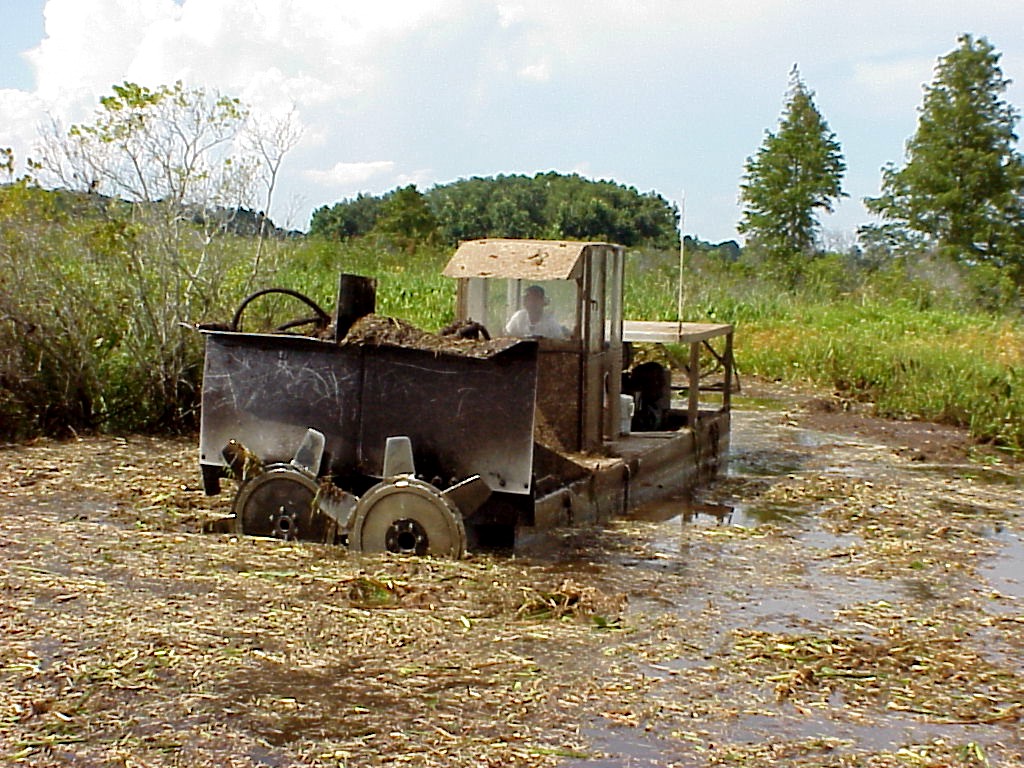Shredders
Machinery that chops and cuts herbaceous and woody plant materials and organic sediments and allows them to sink to the bottom, or facilitates the harvest of floating debris.
Considerations:
(Refer to floating island and tussocks to understand origin and impacts.)
Water uses and functions
- Applied when other control methods are not feasible or when expedited control is required
- Control floating masses of peat, or muck that cannot be controlled with herbicides
- Control floating islands or tussocks in emergency situations
- Flood control
- Shred jams in flood control structures
- Unplug jams in outfall canals, streams, rivers, or other conveyances
- Transportation / navigation
- Shred plant masses or organic material jammed against bridges
- Shred plant masses or organic material blocking established navigation channels
- Control drifting floating islands or tussocks in urgent or preemptive situations
- Prevent potential damage to public and private property i.e. docks, bridges, etc.
- Recreation and safety – prevent blockages to trails and public boat ramps
Fish and wildlife
- Avoid shredding during wildlife nesting or fish bedding periods if possible
- Prevent plant masses from covering valuable fish and wildlife habitat
- Non-selective – controls plants and animals that cannot escape its path
Control feasibility
- Shredding generally proceeds faster and is less expensive that harvesting
- Expenses are generally high
- Acquisition cost of machinery
- High maintenance
- Operating costs – depends on plant type and suspended organic composition
- herbaceous vs. woody plants vs. trees up to 10 inches in diameter
- no suspended organic material to peat up to four feet thick
- Minimize adverse impacts to extent possible when shredding floating islands or tussocks
- More difficult in emergency than urgent or preventive situations
- Turbidity
- Shred from interior of floating island or tussock toward outside
- Leave edge for containment barrier
- Allow as much shredded material to sink or decompose prior to harvesting barrier
- Sediment accumulation
- Shred floating islands where they arise – return organic material to point of origin
- Shred as finely as possible to enhance decomposition
- Try to avoid:
- repeated shredding in same area
- shredding on residential shoreline or public beaches
- in canals or established navigation channels
- Harvest floating shredded material where feasible – refer to harvesting considerations
- Most material sinks to bottom while some remains at surface
- Gasses build up during decomposition and may resurface organic material
- Allowing shredded material to remain at surface as long as possible
- Exposure to air enhances decomposition and compacts organics
- Reshred material or harvest when vegetation grows over exposed organics
- Push or guide floating islands to lower use or value area if possible prior to shredding
Other considerations
- Avoid shredding notches or irregular areas in fixed-in-place tussocks or floating islands
- Wind or water currents will catch edge breaking new material loose
Examples of Feasible Control:
- Emergency shredding of floating islands blocking structures or outfalls alleviated flooding in Marion Creek, and Lakes Hancock, Miccosukee, Apopka and Runnymeade
- Emergency shredding of floating tussocks prevented damage to bridges over the Withlacoochee and St Johns Rivers
- Shredding drifting islands in Orange Lake and Tsala Apopka prevented boaters from being stranded and prevented from returning to public boat ramps
- Shredding and harvesting drifting floating islands in Lakes Pierce and Apopka prevented further damage to boat docks and boat ramps
- Shredding reopened navigation channels overgrown by floating tussocks in tributary creeks of the St Johns River and Lake Lafayette
- Shredders chopped up about 1,000 acres of floating islands and tussocks to facilitate dredging operations on Lake Panasoffkee


